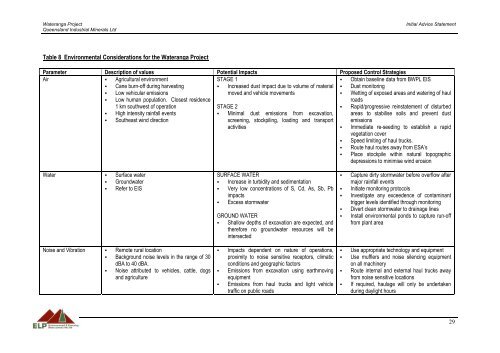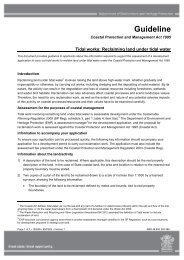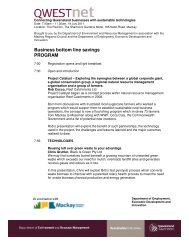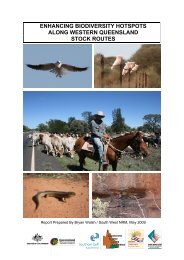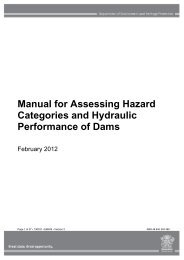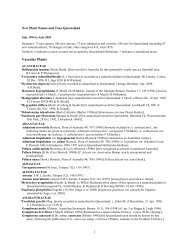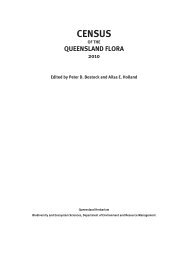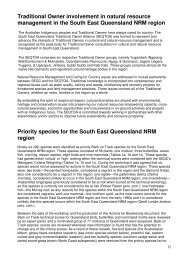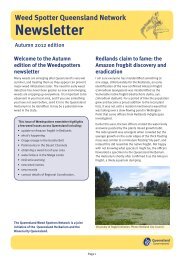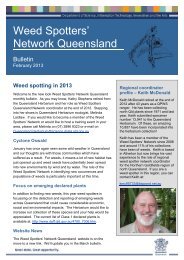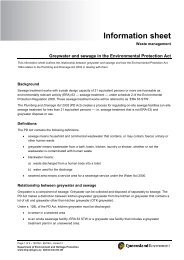WATERANGA PROJECT - Department of Environment and Heritage ...
WATERANGA PROJECT - Department of Environment and Heritage ...
WATERANGA PROJECT - Department of Environment and Heritage ...
Create successful ePaper yourself
Turn your PDF publications into a flip-book with our unique Google optimized e-Paper software.
Wateranga Project Initial Advice Statement<br />
Queensl<strong>and</strong> Industrial Minerals Ltd<br />
Table 8 <strong>Environment</strong>al Considerations for the Wateranga Project<br />
Parameter Description <strong>of</strong> values Potential Impacts Proposed Control Strategies<br />
Air Agricultural environment<br />
Cane burn-<strong>of</strong>f during harvesting<br />
Low vehicular emissions<br />
Low human population. Closest residence<br />
1 km southwest <strong>of</strong> operation<br />
High intensity rainfall events<br />
Southeast wind direction<br />
Water Surface water<br />
Groundwater<br />
Refer to EIS<br />
Noise <strong>and</strong> Vibration Remote rural location<br />
Background noise levels in the range <strong>of</strong> 30<br />
dBA to 40 dBA.<br />
Noise attributed to vehicles, cattle, dogs<br />
<strong>and</strong> agriculture<br />
STAGE 1<br />
Increased dust impact due to volume <strong>of</strong> material<br />
moved <strong>and</strong> vehicle movements<br />
STAGE 2<br />
Minimal dust emissions from excavation,<br />
screening, stockpiling, loading <strong>and</strong> transport<br />
activities<br />
SURFACE WATER<br />
Increase in turbidity <strong>and</strong> sedimentation<br />
Very low concentrations <strong>of</strong> S, Cd, As, Sb, Pb<br />
impacts<br />
Excess stormwater<br />
GROUND WATER<br />
Shallow depths <strong>of</strong> excavation are expected, <strong>and</strong><br />
therefore no groundwater resources will be<br />
intersected<br />
Impacts dependent on nature <strong>of</strong> operations,<br />
proximity to noise sensitive receptors, climatic<br />
conditions <strong>and</strong> geographic factors<br />
Emissions from excavation using earthmoving<br />
equipment<br />
Emissions from haul trucks <strong>and</strong> light vehicle<br />
traffic on public roads<br />
Obtain baseline data from BWPL EIS<br />
Dust monitoring<br />
Wetting <strong>of</strong> exposed areas <strong>and</strong> watering <strong>of</strong> haul<br />
roads<br />
Rapid/progressive reinstatement <strong>of</strong> disturbed<br />
areas to stabilise soils <strong>and</strong> prevent dust<br />
emissions<br />
Immediate re-seeding to establish a rapid<br />
vegetation cover<br />
Speed limiting <strong>of</strong> haul trucks.<br />
Route haul routes away from ESA’s<br />
Place stockpile within natural topographic<br />
depressions to minimise wind erosion<br />
Capture dirty stormwater before overflow after<br />
major rainfall events<br />
Initiate monitoring protocols<br />
Investigate any exceedence <strong>of</strong> contaminant<br />
trigger levels identified through monitoring<br />
Divert clean stormwater to drainage lines<br />
Install environmental ponds to capture run-<strong>of</strong>f<br />
from plant area<br />
Use appropriate technology <strong>and</strong> equipment<br />
Use mufflers <strong>and</strong> noise silencing equipment<br />
on all machinery<br />
Route internal <strong>and</strong> external haul trucks away<br />
from noise sensitive locations<br />
If required, haulage will only be undertaken<br />
during daylight hours<br />
29


